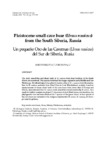Pleistocene small cave bear (Ursus rossicus) from the South Siberia, Russia

Ver/
Use este enlace para citar
http://hdl.handle.net/2183/6537Coleccións
Metadatos
Mostrar o rexistro completo do ítemTítulo
Pleistocene small cave bear (Ursus rossicus) from the South Siberia, RussiaTítulo(s) alternativo(s)
Un pequeño Oso de las Cavernas (Ursus rossicus) del Sur de Siberia, Rusia BARYSHNIKOV, G.Data
2001Cita bibliográfica
Cadernos do Laboratorio Xeolóxico de Laxe, 2001, 26: 373-398 ISSN: 00213-4497
Resumo
[Abstract] The skull, mandibles and cheek teeth of U. Rossicus from four localities of the South Siberia are examined. This species inhabited the steppe regions in early Middle and Late Pleistocene. By odontological characters it is more close to U. r. Rossicus from Krasnodar, than to U. Rossicus uralensis from Kizel Cave in Ural. Discriminant analysis, based on measurements of lower cheek teeth of the cave bears from seven sites of Europe and Siberia, demonstrated that U. Rossicus most resembles morphometrically U. Savini . As a result of cladistic analysis employed 17 characters of skull, limb bones, and dentition, the phylogenetic tree has been obtained for 7 species of the genus U r s u s . A four species of the cave bears are included in the subgenus Spelearctos: U. savini, U. rossicus, U. deningeri and U. spelaeus
Palabras chave
Cave bears
Ursus
Siberia
Pleistocene
Evolution
Ursus
Siberia
Pleistocene
Evolution
ISSN
0213-4497





